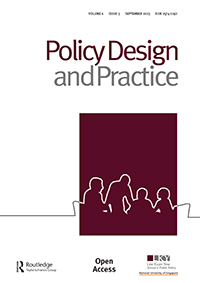民主创新的参与式设计:苏格兰的参与请求和社区赋权
IF 2.6
Q1 PUBLIC ADMINISTRATION
引用次数: 2
摘要
摘要在过去的十年里,越来越多的研究探索了在政策制定中应用设计方法的潜力,从而出现了一种新的实践,称为“政策设计”。虽然基本上取得了成功,但政策流程设计的细节仍存在疑问。在这方面,争论的关键点与政府-公民审议和合作的框架方式有关(即,谁可以参与政策举措的设计以及如何参与),以及设计在过程中的作用(即,它是解决问题的手段还是框架问题的手段)。为了应对这些挑战,本文通过研究一种特定设计方法——参与式设计(PD)——在政策设计中的潜力,转向苏格兰的政策制定背景。在这里,我们介绍了一个名为Social Studios的项目的案例研究,该项目探讨了PD如何使社区更好地处理参与请求(PR)——这是《社区赋权(苏格兰)法》(2015)中的一种机制,允许团体就与基础设施和服务相关的地方问题与公共当局接触。从研究背景的初步概述来看,我们描述了研究的方法、过程,最后是研究的结果——定制的“公关工具箱”。文章最后对PD在政策设计背景下的更广泛潜力进行了一系列思考。本文章由计算机程序翻译,如有差异,请以英文原文为准。
Participatory design for democratic innovation: participation requests and community empowerment in Scotland
Abstract Over the last decade, a growing body of research has explored the potential of applying design approaches within policymaking, resulting in the emergence of a novel practice, termed ‘design for policy’. While largely successful, questions remain regarding the specifics of the design for policy process. In this, key points of contention relate to the way government-citizen deliberation and collaboration is framed (i.e., who gets to participate in design for policy initiatives and how), as well as the of the role of design within the process (i.e., is it a means of problem-solving or problem-framing). Responding to these challenges by examining the potential of a specific design approach—Participatory Design (PD)—in design for policy, the present article turns to the Scottish policymaking context. Here, we present a case study of a project titled Social Studios, which explored how PD might enable communities to better approach Participation Requests (PRs)–a mechanism within the Community Empowerment (Scotland) Act (2015) that allows groups to engage with public authorities on local issues relating to infrastructure and services. From an initial overview of the context of the study, we describe its methods, process and, finally, its outcome—a bespoke ‘PR Toolbox’. The article then closes with a series of reflections on the broader potential of PD in the context of design for policy.
求助全文
通过发布文献求助,成功后即可免费获取论文全文。
去求助
来源期刊

Policy Design and Practice
PUBLIC ADMINISTRATION-
CiteScore
10.30
自引率
4.30%
发文量
19
审稿时长
13 weeks
期刊介绍:
 求助内容:
求助内容: 应助结果提醒方式:
应助结果提醒方式:


